Analytical Instrumentation
Gas Chromatography-Mass Spectrometry (GC-MS) is a dual technique that combines an ordinary gas chromatograph with a quadrupole mass spectrometer acting as the detector. The gas chromatograph is able to separate a liquid or gaseous mixture into its components and then the mass spectrometer measures the amount of each compound. With mass spectrometry, the user also receives information about the composition of molecules in the sample, allowing unknown components to be identified. Students gain experience with this instrument in CHEM 330: Instrumental Methods of Analysis and some other courses. This instrument was purchased new in 2015 with funding from the Science Initiative.
TA Instruments Q20 Differential Scanning Calorimeter
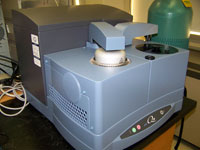
The Differential Scanning Calorimeter (DSC) can be used to investigate the thermal properties of substances such as polymers and crystals. A small aluminum pan is filled with a sample and heated or cooled in a very precise furnace. The amount of heat absorbed or released by the sample, compared to an empty reference pan, is recorded. From the resulting plot, phase transition temperatures (for example, the melting point) can be identified and their changes in enthalpy and entropy can be calculated. This instrument includes an auto-sampler which can be programmed for up to fifty samples, making it useful in larger classes. This instrument was purchased new in 2009 with funding from the Science Initiative.
Buck Scientific 210 VGP Atomic Absorption Spectrophotometer

Atomic Absorption (AA) is primarily used to determine the concentrations of elements in solution and it is particularly useful for metallic elements, such as copper and lead. A very hot flame is used to break molecules into individual atoms and then a single type of atom is detected using a special lamp system. This instrument is used for analysis in courses such as CHEM 122: General Chemistry II and CHEM 230: Quantitative Analysis.
Thermo Scientific Evolution 300 Ultraviolet-visible Spectrophotometer
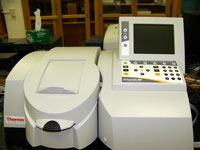
This spectrometer operates in the ultraviolet and visible regions of the spectrum. It has two main modes. In one mode, the amount of light absorbed by a sample is measured over a range of wavelengths, producing a graph known as an absorption spectrum, which can provide information about the structure of molecules in the sample solution. In the other mode, the light absorbed by a sample is measured at a single wavelength and compared to standards with known concentration in order to determine the concentration of one component of the sample. Both modes are used routinely in chemistry courses and this type of spectrometer is one of the first that students will learn to use. This instrument was purchased new in 2008 with funding from the Science Initiative. It also has an attachment that allows the temperature of the sample to be adjusted during measurement.
Jasco FTIR-4100 Infrared Spectrophotometer with Pike MIRacle ATR
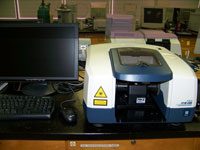
Fourier-Transform Infrared (FTIR) spectrometry employs wavelengths in the infrared region of the spectrum to investigate bonding and functional groups in molecules. This technique is useful primarily for organic chemistry in which a compound may be identified from its absorption spectrum. At Aquinas, students regularly use this instrument in CHEM 221: Organic Chemistry I and CHEM 222: Organic Chemistry II. The Attenuated Total Reflectance (ATR) accessory allows users to collect spectra quickly and without extensive sample preparation. This instrument was purchased new in 2007 with funding from the Science Initiative.
Horiba/Jobin Yvon Fluoromax-4 Spectrofluorometer

Fluorescence is the light emitted by an excited molecule. Not all molecules fluoresce, but those that do can be investigated using this instrument. The spectrofluorometer can be used either qualitatively or quantitatively. Studies of reaction kinetics are also possible with the accessory that allows one to change the temperature of a sample during a measurement. Students use this instrument in CHEM 330: Instrumental Methods of Analysis and some other courses. This instrument was purchased new in 2008 with funding from the Science Initiative.
Anasazi Eft-60 Nuclear Magnetic Resonance Spectrometer
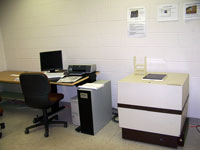
Nuclear Magnetic Resonance (NMR) is a technique that probes a single type of atomic nucleus in a sample. These nuclei provide information about the structures of molecules in that sample. The original Varian instrument at Aquinas was upgraded in 2005 with Fourier-Transform software and a new probe for hydrogen-1 nuclei (protons) and further improved in 2006 with the capacity for carbon-13 nuclei using funds from the Science Initiative. Students use the instrument primarily for CHEM 222: Organic Chemistry II and CHEM 330: Instrumental Methods of Analysis.
Agilent 1100 Series High-Performance Liquid Chromatograph
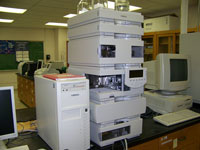
High-performance liquid chromatography (HPLC) is a separation technique that employs a pressurized mixture of solvents to pump a sample through a short packed column. Different types of molecules in the sample pass through the column at different rates, and thus elute from the end of the column at different times. As the sample passes out of the column, molecules are detected with a tiny version of an UV-vis spectrophotometer. Sophisticated software controls the instrument and displays the resulting data. The department has two identical instruments of this type, which were acquired as donations from Pfizer's Holland Research and Development laboratory in 2003. Students primarily use HPLC in CHEM 330: Instrumental Methods of Analysis.
Hewlett Packard 6850 Series Gas Chromatograph
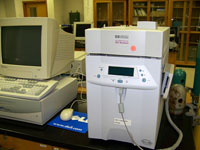
Gas chromatography (GC) is a separation technique that employs an inert gas, such as nitrogen or helium, to force a gaseous sample through a very long capillary column. Different types of molecules in the sample experience stronger or weaker interactions with the coating on the inside surface of the capillary, thus passing through the column at different rates. As each type of molecule exits the column, it is detected by the Flame Ionization Detector (FID). A dedicated computer with specialized software controls the instrument and displays the resulting data. This instrument was acquired as a donation from Pfizer's Holland Research and Development laboratory in 2003. Students use GC in CHEM 221: Organic Chemistry I, CHEM 222: Organic Chemistry II, and CHEM 330: Instrumental Methods of Analysis.